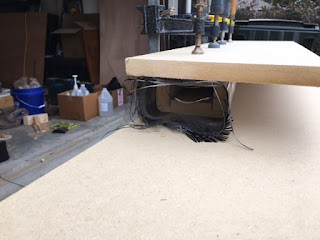Next I added another healthy stack of material over that to stiffen and distribute the load from the mast base.
Next up was the remaining bulkheads. This would include the aft centerboard trunk bulkhead and the aft cockpit bulkhead. I'm really happy with the shape of the boat with the temporary bulkheads in and I'm pretty sure the boat is off script from the initial design. I pulled the shape from inside of the hull using a jig I made and 1.5" strips of plywood that slid down the slot in the top. I then transferred the shape to some construction paper for the bulkhead pattern. It worked great!
Transferred to the pattern material:
Reminds me of a calculus class. Area under the curve, anybody? Nerdy engineering moment there. If you know what I'm talking about feel free to comment. This process was repeated for the remaining bulkhead locations. I cut out and glued in these bulkheads. The cockpit geometry is starting emerge now. I like it.
Next up I glued in .750 x .500 rails around the perimeter of the bulkheads where the deck will attach. This added structure and gives me a surface to bond the deck too.
All clamped up:
To increase the stiffness of the transom where the rudder will eventually attach, I added a composite laminate to that area. I did the same at the bottom of the aft cockpit bulkhead where the hiking straps will bolt in too.

























